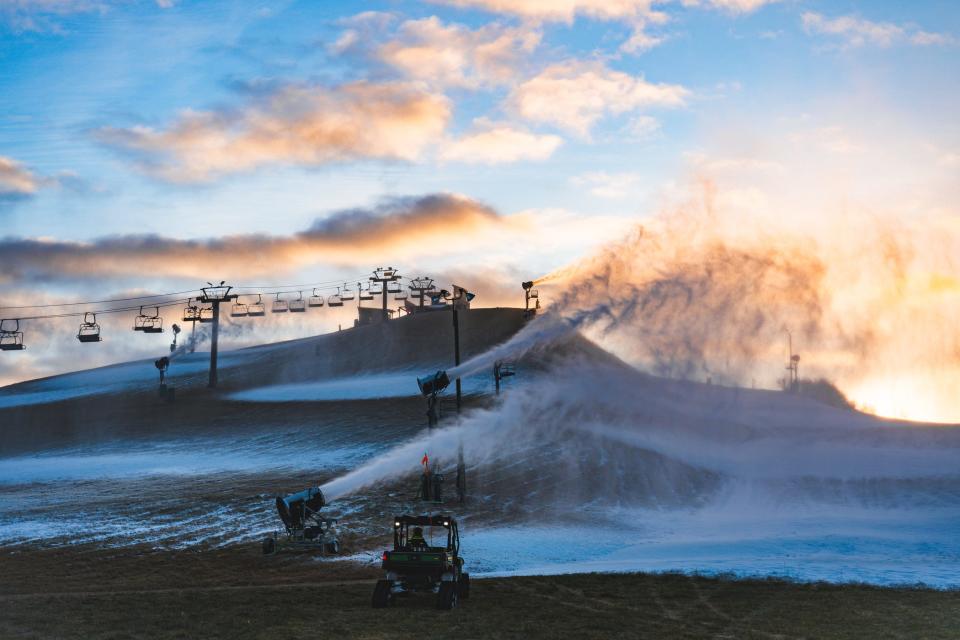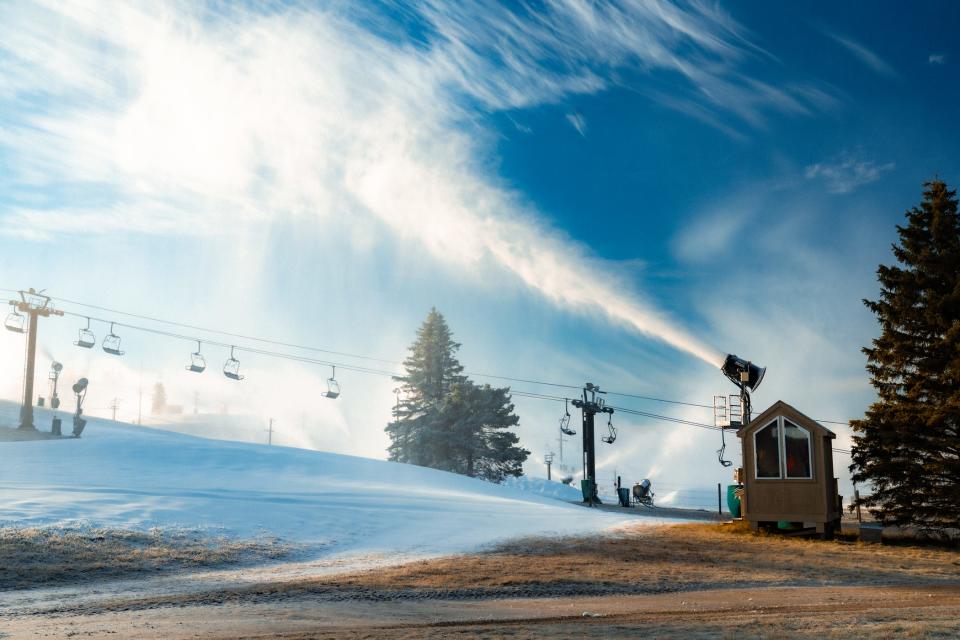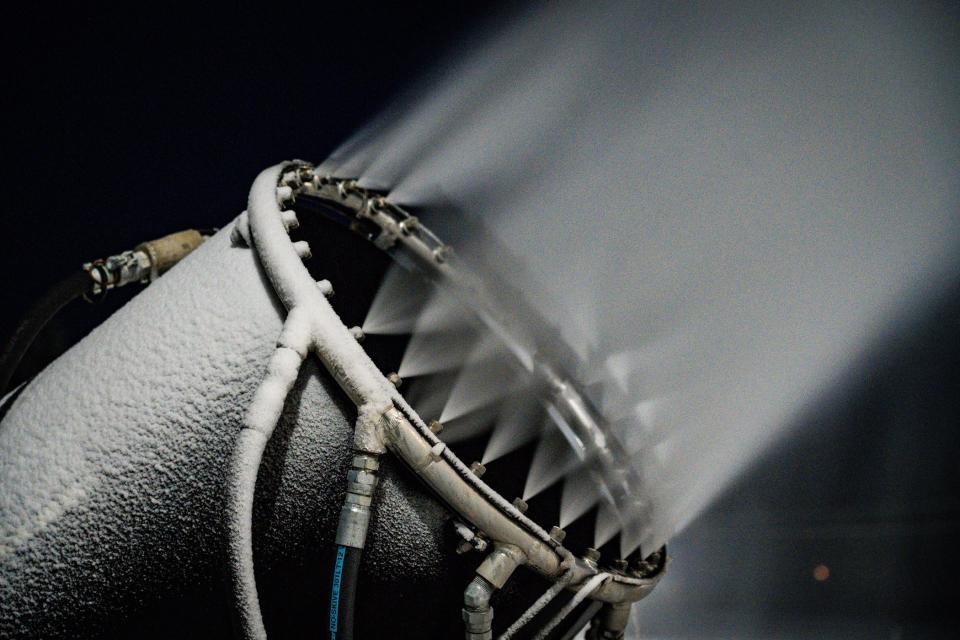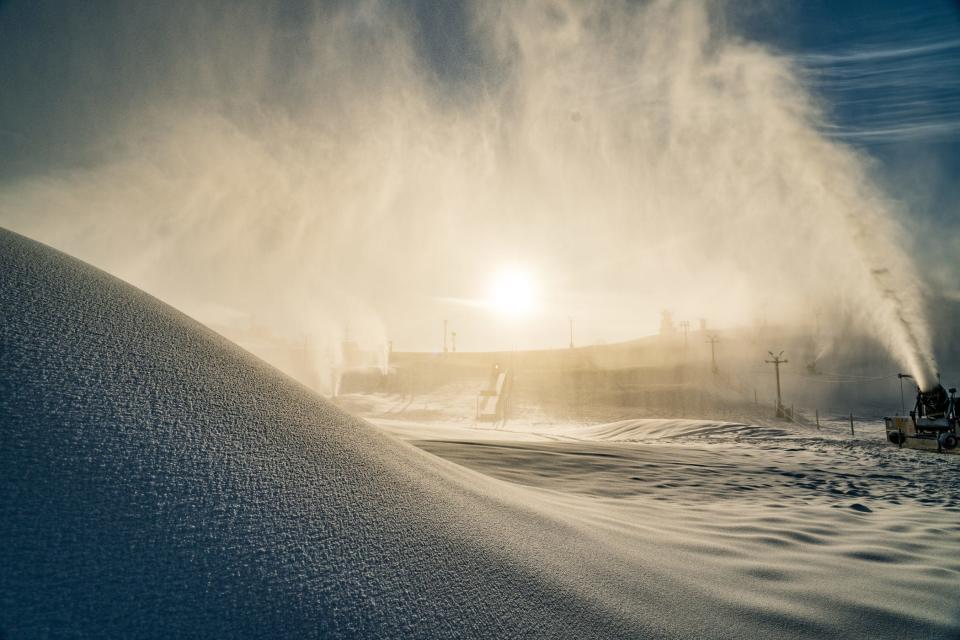Michigan ski resorts relied on snow machines to stay open during warm winter
As the ski season comes to an end, it's worth examining the tool that helped many ski resorts to survive this warmer, drier-than-usual winter: snow machines.
While some ski resorts rely on traditional sky-made snow with snow machines only to supplement their slopes, other locations, like Mount Brighton in Brighton, have operated for decades using the opposite strategy — which ended up being a superior investment this year.

Mount Brighton has relied on snowmaking technology since its start almost 63 years ago, says general manager Mike Giorgio.
“Snowmaking is imperative to our operation," said Giorgio. "We have always relied on snowmaking to get our seasons going and expand our terrain. Obviously, help from Mother Nature goes a long way, but we’re pretty locked in on the idea that snowmaking is a necessity in Michigan.”
In normal years, slopes in southern Michigan might get a couple dozen inches of snow a year — which still isn't enough to build an appropriate snowpack, said Giorgio — but after the warmer temperatures we've experienced this season, that number has fallen significantly short, causing several ski resorts to close up earlier than usual.
“Historically, we try to make it as far into March as possible; this year is obviously quite different with multiple days of rain and 60-plus degrees in the forecast for the next 10 days," said Giorgio. "We feel pretty confident that we’ll make it into March and a couple days beyond. We’ll stay open as long as we possibly can. ... It’s definitely more difficult this season but if we didn’t have the snowmaking capabilities that we do, we would’ve never opened.”
More: Mild winter jeopardizes skiing, dog sled racing, snowmobiling in northern Michigan
Other Michigan ski resorts in more northern, cooler parts of Michigan, like Crystal Mountain near Traverse City, are confident they'll stay open through March into early April — all thanks to whatever snow machines they had at the ready when this proved to be a warm winter early on.
What is a snow machine and how do they make snow?
As you might expect, snow machines provide another way for ski resorts and other snow-dependent places to obtain snow when the environment is less willing to create the flakes for free.
When snowfall occurs the organic way, water particles freeze onto dust or pollen particles to form an ice crystal — this process is called "nucleation" — and as the icy speck falls to the ground, more water molecules freeze onto the crystal and form the feathered arms to create, all together, what we would call a snowflake.
Snow machines have the tough task of replicating this process fast.
"We use compressed air and a nucleator to create a seed-like ice crystal for the water to attach to and create our version of a snowflake," said Brooke Alba, vice president of sales and marketing at SnowMakers Inc. Headquartered in Midland, SnowMakers Inc. provides snowmaking equipment to snow-dependent businesses all over the world, even selling to the Winter Olympics.
Once water droplets fall, hit, and freeze to the ice crystals, a fan blasts the snow out into the air, creating the tall plume of white that you might find drifting over ski slopes in southern Michigan.

When the snow floats down from the air, it accumulates into piles until a snow groomer evenly distributes it across needed areas.
Unfortunately, manufactured snow doesn't fall long enough to develop all of the pretty intricacies of a natural snowflake, but at the end of the day, there's no doubt that it's snow.
"People usually think of the dendritic arms when they think of a snowflake but ... It is real snow," said Alba. "Ours kind of looks more like a pellet or a BB, which actually allows it to withstand temperature changes, so a lot of times at the end of the season you'll see that trails with machine-made snow will be the last to melt."
What outdoor conditions are needed to create and maintain man-made snow?
There are two main conditions that Alba listed: "wet-bulb temperature" and wind.
Wet-bulb temperature measures the relationship between temperature and humidity. Snow can be created in below-freezing and high-humidity conditions or in above-freezing and extremely low-humidity conditions; it's just a matter of snowmakers finding a balance between the two to produce a first-rate freeze.
Wind, on the other hand, can help or hinder snowmaking. Wind is needed to pick the snow up once it's expelled from the snow machines and distribute it evenly across the slopes, but if the wind is blowing in the wrong direction, a large amount of snow may be lost to inaccessible areas. Also, better wind allows for more hang time: more time that the snow spends in the air, allowing it to develop and freeze before landing on the ground.
What kinds of snow machines are there?
Snow machines fall into two categories, said Alba: fan machines and stick machines. However, the fan snow machines are much more common on Michigan slopes.
"The fans are what you'll see more in Michigan because they do better in what we call 'marginal conditions,' " said Alba. "To make snow the traditional way, you need temperatures of 28 degrees wet-bulb or below. So, in what we call marginal conditions, which would be between 25 and 28 degrees, the fan snowmakers do a better job of converting water to snow at those temperatures ... That's why you'll see that more in Michigan since we get such big temperature swings, especially in southeast Michigan."

How much do snow machines cost?
There are different models and different installation methods that make for a range of costs, but Alba commented that the price point of a snow machine is usually similar to that of a car.
According to a 2016 article by EMS Environmental, while stick snow guns may cost around $5,000-6,000, fan snow guns can cost between $28,000-35,000, with additional installation fees bringing a potential sum up to $50,000.
How many snow machines are needed to cover a resort in snow?
As you can imagine, the amount of snow machines needed to turn a barren ski resort into a winter wonderland depends on its acreage, but Alba said that SnowMakers Inc.'s best and biggest fans can cover a football field with 4 inches of snow in 12 hours.

For example, Mount Brighton has 67 snow machines — 23 of which are portable — to cover its 120-acre property. Their machines pump out up to 3,200 gallons of water per minute, said Giorgio, but a lot of the success in converting the water to snow is dependent on weather conditions.
More: Great Lakes ice cover at record low for this time of winter
“The colder it is, the more we can pump and the more snow we can make,” said Giorgio. “If we have a solid 48 hours of snowmaking, we can go from totally green to 100% open, assuming the temperatures and all the variables are in place.”
Are snow machines safe for the environment?
Just like nature, snow machines produce snow using only air and water. Man-made snow doesn't contain any chemicals, as that would cause many problems for both the environment around the ski resort and its paying customers.
“You can go out and eat it if you wanted to, just like regular snow," said Alba.
In terms of other environmental concerns, Alba says that the companies who manufacture snowmaking equipment try to make their product as energy-efficient as possible.
“Today's units are about five to six times more energy efficient than the models 30 years ago," said Alba. "The ski industry and the outdoor industry definitely takes that as a very important thing.”
Does manufactured snow work the same for snowboarding and skiing?
One of the best parts about the snow machines, Alba says, is that the quality of the snow can be manually modified.
While the average skier or snowboarder may want more soft, fluffy flakes, racing events typically want snow that's more dense and icy — both of which can be altered at the turn of a dial on a snow machine, using more or less water in the snowmaking process.
This article originally appeared on Detroit Free Press: Michigan ski resorts have snowmakers to survive warm winters

